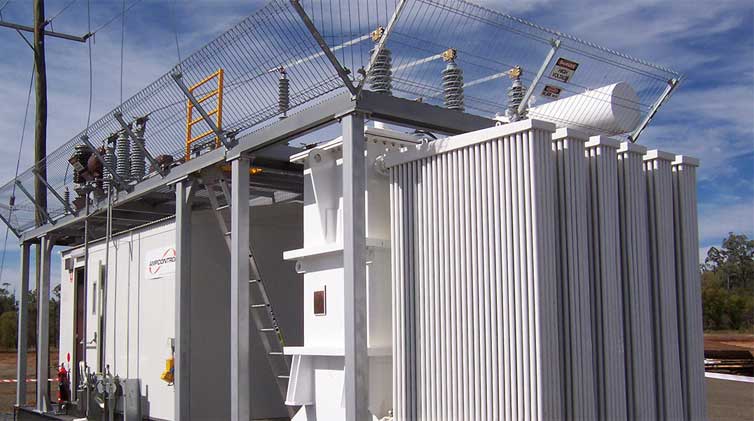Overview of Various Classifications of 10kV Transformers
1. Transformer overview
The 10kV transformer is referred to as "distribution". It refers to a kind of static electric appliance in the distribution system that converts AC voltage and current according to the law of electromagnetic induction and transmits AC electric energy. A 10kV transformer is usually a power transformer that operates in the distribution network with a voltage rating of 10-35kV (mostly 10kV and below) and a capacity of 6300KVA and below directly to the end user.2. Sorted by installation location
The 10kV transformer is divided into indoor and outdoor depending on the installation location. Outdoor installation is divided into platform type, tower type and floor type (including pre-installed type).2.1 pole tower
The tower type is a structure in which a transformer is mounted on a pole. It is divided into single pole and double pole.When the 10kV transformer capacity is 30KVA or less (including 30KVA), a single pole 10kV transformer gantry is generally used. Install a 10kV transformer, high-voltage drop fuse and high-voltage arrester on a cement rod. The shaft should be tilted 13°-15° in the opposite direction of the assembled 10kV transformer.
When the 10kV transformer capacity is between 50KVA and 315KVA, a double-pole 10kV transformer station is generally used. The 10kV transformer stage consists of a main rod cement rod and another auxiliary rod. The main pole is equipped with a high voltage drop fuse and a high voltage down conductor, and the secondary pole has a secondary reverse lead. The double pole 10kV transformer stage is sturdy with a single pole 10kV transformer.
The advantages of the tower type installation: the land occupation is small, the surrounding wall does not need to be fenced or covered, and the charged part is higher than the ground, which is not easy to cause accidents.
Disadvantages: The rack needs more steel and the cost is higher.
2.2 Pier type
The pier type is a square pier with 0.5-1 m masonry under the transformer pole, and the transformer is placed on it. Generally, a transformer of 315KVA or more is installed.
Pay attention to the following three points when installing a pier type transformer:
(1) A solid barrier or masonry wall of not less than 1.8m shall be installed around the transformer. The door shall be locked and kept by a special person.
(2) The barrier and fence should have sufficient safe operating distance from the transformer.
(3) Warning signs such as "high-pressure danger, no climbing" should be hung on poles or fences to prevent people and animals from approaching.
Advantages of the pier type installation: it is low in cost and easy to maintain and repair.
Disadvantages: It occupies a large area, and it is necessary to install a fence around it. Small animals are easy to climb to the charged part, which is prone to damage caused by external forces.
2.3 Floor type
Floor-standing means that the transformer is placed directly on the ground, and the high-voltage down-conductor, the drop-out fuse and the arrester are all on the line terminal rod. Pay attention to the following three points when installing a floor-standing transformer:
(1) A reliable fence must be installed around the transformer. The door should be locked and kept by a specific person.
(2) Warning signs such as "high voltage danger, no climbing" shall be hanged outside the fence.
(3) Since the live part of the transformer is very low from the ground, the person must enter the barrier after cutting off the power.
3. Classified by cooling method
According to the cooling method, it can be divided into oil-immersed and dry-type transformers.Oil-immersed transformers rely on oil as a cooling medium, such as oil-immersed self-cooling, oil-infiltrated air-cooled, oil-immersed water-cooled, forced oil circulation, and the like. Dry-type transformers rely on air convection for natural cooling or increased fan cooling. They are used in small-capacity transformers such as high-rise buildings, high-speed toll stations, and local lighting and electronic circuits.
3.1 Oil-immersed transformers are divided into:
1) Non-closed oil-immersed transformer: It mainly has S8, S9, S10 and other series products, which are widely used in industrial and mining enterprises, agriculture and civil buildings.
2) Closed-type oil-immersed transformer: It mainly has S9, S9-M, S10-M and other series of products, which are mostly used in places with multiple oil and chemical substances in petroleum and chemical industries.
3) Sealed oil-immersed transformer: It mainly has BS9, S9-, S10-, S11-MR, SH, SH12-M and other series products, which can be used for power distribution in industrial and mining enterprises, agriculture, civil buildings and other places.
3.2 Dry type transformers are divided into:
1) Encapsulated coil type dry-type transformer: It mainly has SCB8, SC(B)9, SC(B)10, SCR-10 and other series products, suitable for high-rise buildings, commercial centers, airports, stations, subways, hospitals, factory and other places
2) Non-encapsulated coil dry-type transformer: It mainly has SG10 series products, suitable for high-rise buildings, commercial centers, airports, stations, subways, petrochemicals and other places.
4. Electric voltage regulation
According to the voltage regulation method, it can be divided into on-load voltage regulation and no-load voltage regulation.The so-called no-load voltage regulation and on-load voltage regulation all refer to the transformer tap changer voltage regulation mode. The difference is that the unloaded regulator switch does not have the ability to load shift gears, and the transformer must be powered off when shifting. The on-load tap-changer can be switched with load.5. Phase number classification
According to the number of phases, it is divided into single-phase transformer and three-phase transformer.A single-phase transformer is a transformer in which the primary winding and the secondary winding are single-phase windings. The single-phase transformer has a simple structure, small volume and low loss, and is mainly small in iron loss, and is suitable for application and promotion in a low-voltage distribution network with a small load density.Three-phase transformers are used for the rise and fall voltages of three-phase systems. For a three-phase transformer, there are generally three primary windings, which are divided into triangles and stars, and extended triangles. The voltages on the three windings are 120 degrees out of phase, which is the common three-phase 380 volt connection. The core of the iron core is a three-phase three-core column, a three-phase five-core column, and an involute shape.YueBian Electric Co.,Ltd is a professional 10kv oil transformer supplier. Welcome to purchase.
Jump to Content Sections
Leave a Message
You May Also Like
 English
English  français
français  Español
Español  русский
русский  العربية
العربية  tiếng việt
tiếng việt  Malay
Malay  Indonesia
Indonesia  বাঙালি
বাঙালি 


